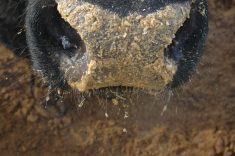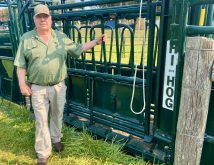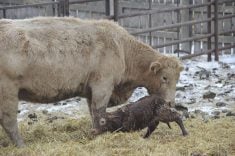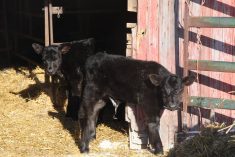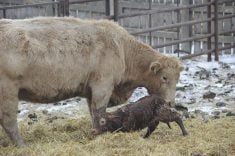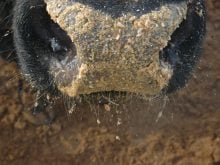Veterinarians say not all cases can be prevented, which makes early detection and treatment particularly important
Diarrhea is the number one killer of calves in their first weeks of life.
Even with the best prevention strategies, some calves get sick if they don’t get enough colostrum or are severely stressed by bad weather that compromises their immune systems.
Not all cases can be prevented so early detection and treatment are important.
“In the past decade we have not seen as many cases of scours brought here to be treated with IV fluids,” says Dr. Chris Clark of the Western College of Veterinary Medicine at the University of Saskatchewan.
Read Also

Quebec pork company calls for transparency around gene-edited pigs
Quebec-based pork company duBreton is calling for transparency around meats from gene-edited pigs on concerns that a lack of mandatory labelling will confuse consumers, and dilute certification claims. The organic sector is also calling for labelling rules.
“When I first started at the college in the 1990s, we’d see about 200 scouring calves a year. Now it’s down to 10 or less per year. There are several reasons for this, and the cattle industry deserves recognition for advances that have been made in reducing severe cases.” Most ranchers are proactive and try to calve in clean areas and on green grass if possible. Calving later in spring, on pasture rather than in confinement, reduces contamination.
“This, coupled with vaccination of cows ahead of calving and good colostrum management, means we don’t see as many sick calves, and fewer losses,” says Clark.
Though early calving is still common among purebred breeders, Clark says the industry in general “has moved away from winter calving and we see less scours when cows can calve on pasture.”
However, even the best plans can be thwarted by Mother Nature. A late spring snowstorm adds stress and makes conditions more challenging, and some calves still get sick.
“The time of year and the space you have will be factors, along with appropriate use of vaccines, recognizing that vaccine will only benefit the animals if the calves suckle on time,” says Clark.
The cow may have excellent colostrum with lots of antibodies, but if the calf cannot suckle, it does no good.
Dehydration from scours, rather than infection, is what usually kills calves.
“If scours occur in the first week of life, there’s a chance it is bacterial and antibiotics may play an important role in treatment. It’s worth getting a veterinarian involved, sending samples to the lab, and finding out which bacteria are causing the problem,” Clark says.
Then the proper antibiotic can be chosen.
“Once calves are older, it’s more common to have scours caused by a virus or protozoa. In these cases, antibiotics do no good. Fluids are the best treatment. If you could only pick one treatment to give all scouring calves, fluids are the best.”
Clark says most producers abandoned the idea of giving pills or boluses. Other treatments are more effective.
“A calf with diarrhea is losing fluid and electrolytes and you need to replace those. We now have some really good commercial electrolyte products but I don’t recommend high-energy products. If beef calves can stay with their mothers and continue nursing occasionally, this will be adequate to keep their energy level up,” says Clark.
“Most labels recommend giving electrolytes twice a day, but if a calf has severe diarrhea, losing a lot of fluid and electrolytes, it’s better to give these products four times per day.”
These should be administered by tube.
“Treat as soon as you notice scours, if you can catch the calf. If you can’t catch it, the calf is not sick enough to need fluids,” Clark says.
“If the calf just lies there and can’t lift its head and can’t suck your finger, oral fluids won’t be helpful.”
The calf cannot absorb fluids if it is this weak, so intravenous fluids will be needed.
A serious infection in a very young calf can result in severe and rapid dehydration. Fluids and electrolytes may be needed every three to four hours in such cases.
“Young calves don’t have the body and fluid reserves of an older calf. Even by a week of age, most calves have enough reserve to be a little hardier. The good news is that scours vaccine is most effective in preventing scours in these very young calves.
“Most of the scours we see now occur in the eight- to 14-day age period, rather than the first few days of life. Calves are tougher by then, but still need aggressive treatment and perhaps longer treatment than an older, bigger calf,” says Clark.
If the calf is already weak and unable to lift its head when first discovered, don’t try giving oral fluids.
“There’s risk you’ll drown the calf and he can’t absorb fluids anyway because the stomach is shut down.”
This is when a veterinarian is needed to start an IV. Some vets may teach producers how to start intravenous treatment.
“Some people don’t want to try. Putting an IV catheter in a healthy calf is tricky,” says Clark. “Putting it into a dehydrated calf is very difficult” because the vein has usually collapsed due to low blood pressure.
With a severely sick calf, the veterinarian can tailor treatment to that particular animal.
“Veterinarians go to school to learn these things and can be very helpful in saving these calves. Yet the rancher is generally better at spotting the sick calf in the first stages of illness,” says Clark.
“Early recognition is important, and this is where an experienced stock person is best. There can be subtle signs: the calf isn’t quite as perky or its ears aren’t quite right. The skills of a stock person make a big difference.”





